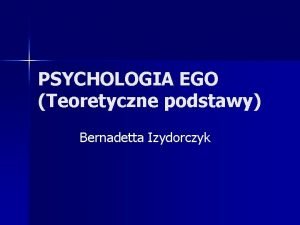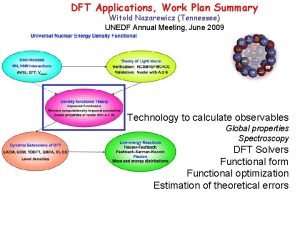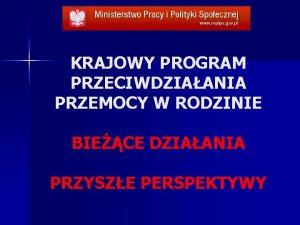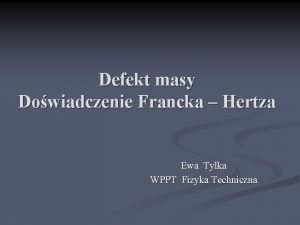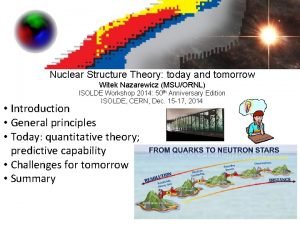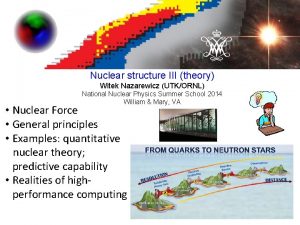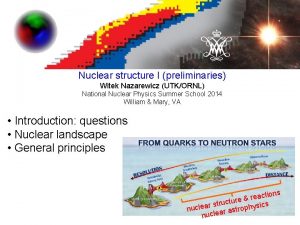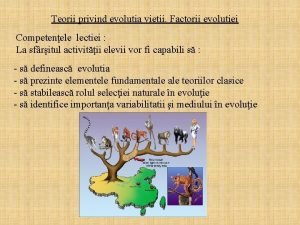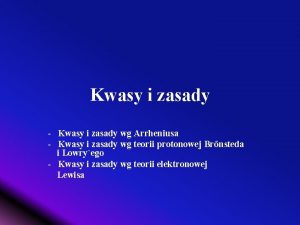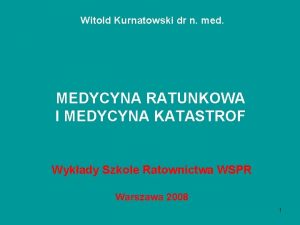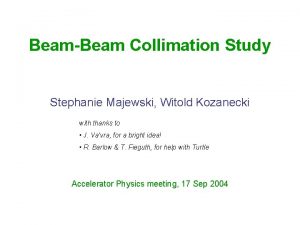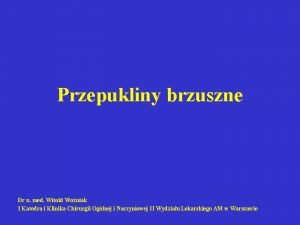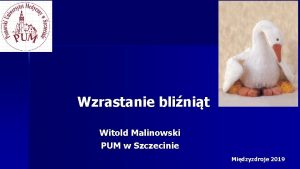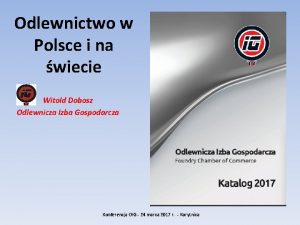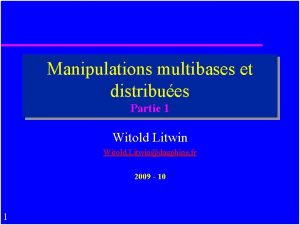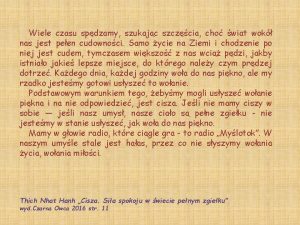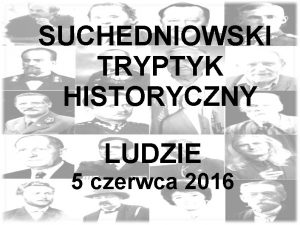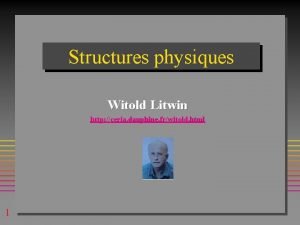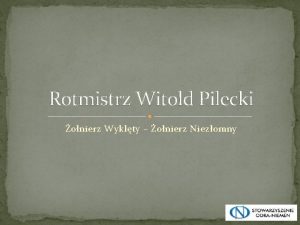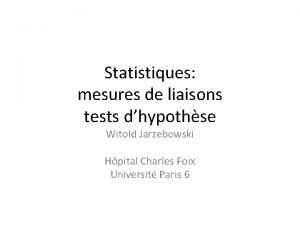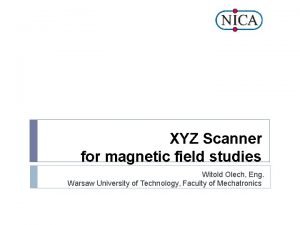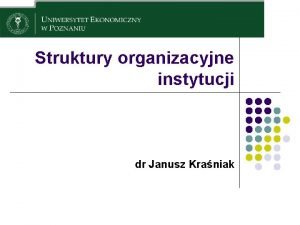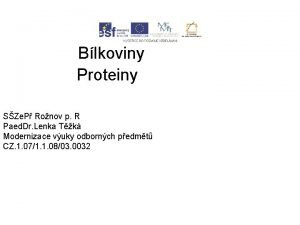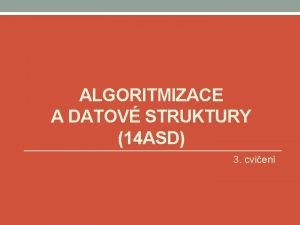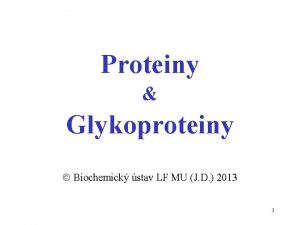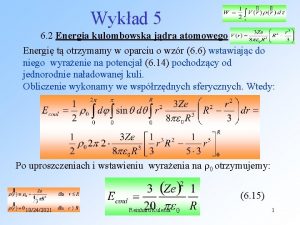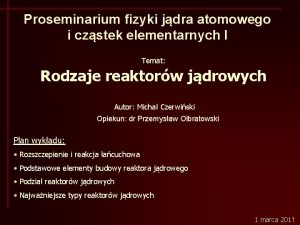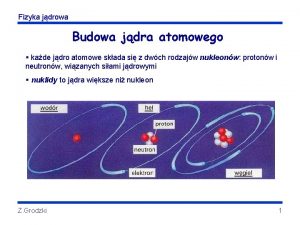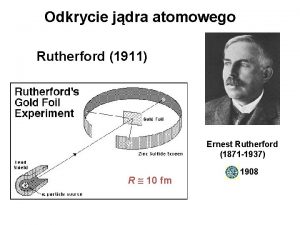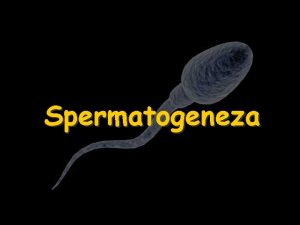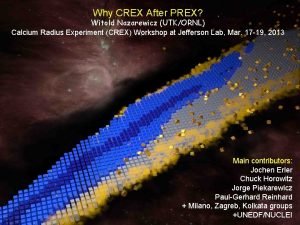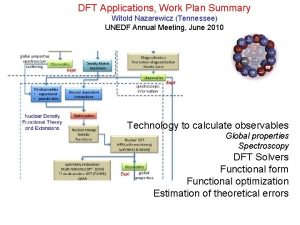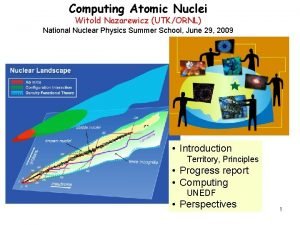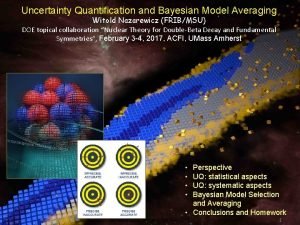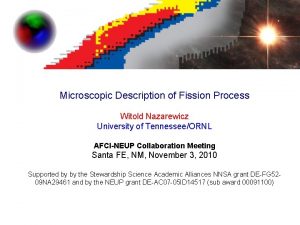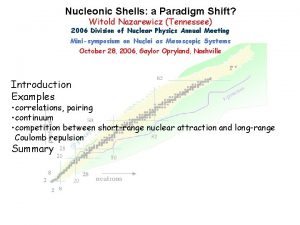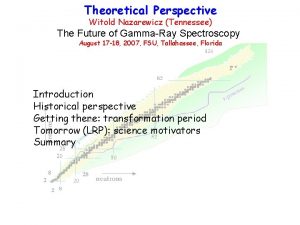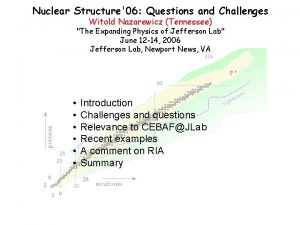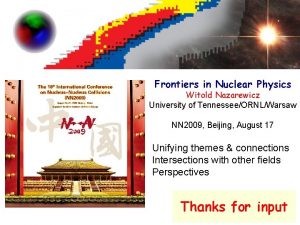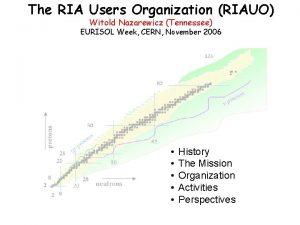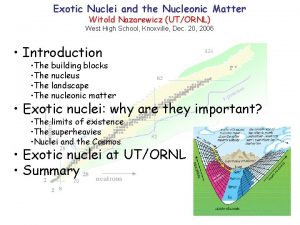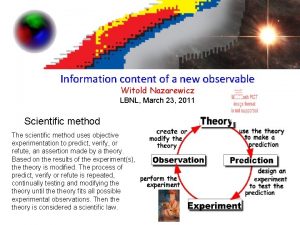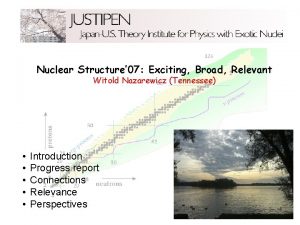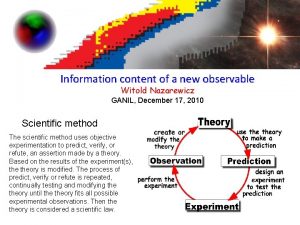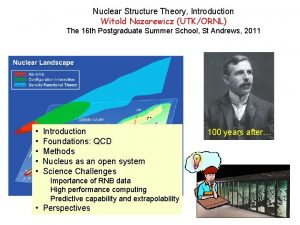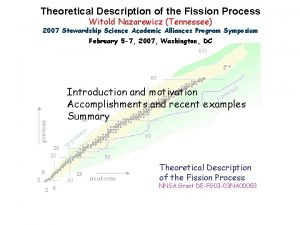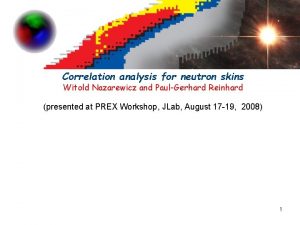Perspektywy Teorii Struktury Jdra Atomowego Witold Nazarewicz TennesseeWarszawa
































- Slides: 32

Perspektywy Teorii Struktury Jądra Atomowego Witold Nazarewicz (Tennessee/Warszawa) Kraków, Maj 2006 • • Wstęp Pytania i zadania dla teorii Modele struktury: dziś i jutro Podsumowanie

The Nuclear Many-Body Problem relativistic heavy ions electron scattering radioactive beams few body y g r e n E heavy nuclei quarks gluons vacuum quark-gluon soup QCD nucleon QCD few body systems many body systems free NN force effective NN force

Energy Scales in Nuclear Physics u g g g _ d _ u d_ ud QCD scale 1000 Me. V pion p+ ~140 Me. V _ _ u d u_d d u u _d_ d ud ud d Effective Field Theory tells us that: pion-mass • Short-range (high-k) physics can bescale integrated out • No need to worry about explicit inclusion of hard coredeuteron • Low-energy phenomena can be described with low-k ~3 Me. V 100 Me. V forces N-binding scale 10 Me. V J. Dobaczewski, RIA Summer School, 2004 collective ~1 Me. V

Questions that Drive the Field of Nuclear Physics with Nucleons • • How do protons and neutrons make stable nuclei and rare isotopes? What is the origin of simple patterns in complex nuclei? What is the equation of state of matter made of nucleons? What are the heaviest nuclei that can exist? Physics of nuclei • • • When and how did the elements from iron to uranium originate? How do stars explode? What is the nature of neutron star matter? Nuclear astrophysics • • Why is there more matter than antimatter? What are the weak interactions among hadrons, and how are they affected by the nucleus? What are the masses of neutrinos and how have they shaped the evolution of the universe? Fundamental interactions & neutrinos • • How can our knowledge of nuclei and our ability to produce them benefit the humankind? – – Life Sciences Material Sciences Nuclear Energy Security Applications of nuclei

Nuclear Structure Theory Overarching goal: To arrive at a comprehensive and unified microscopic description of all nuclei and there low-energy reactions from the basic interactions between the constituent protons and neutrons • This is a lofty and ambitious goal that has been a “Holy Grail” in physics for over fifty years • “Unified” does not mean that there is a single theoretical method that will work in all cases – Self-bound, two-component quantum many-fermion system – Complicated interaction based on QCD with at least two- and threenucleon components – We seek to describe the properties of “nuclei” ranging from the deuteron to neutron stars There is no “one size fits all” theory for nuclei, but all our theoretical approaches need to be linked by an underlying use of the constituents and the interactions between them

Theory roadmap

Nuclear Structure: the interaction • Effective-field theory potentials Parameters for EFT three-nucleon interaction Best EFT threenucleon potential N 3 LO: Entem et al. , PRC 68, 041001 (2003) • Quality two- and three-nucleon interactions exist • The challenge is to understanding how to use them in nuclei

Bottom-up approaches to nuclear structure Roadmap Ab initio Configuration interaction Density Functional Theory Collective and Algebraic Models (top-down) Theoretical approaches overlap and need to be bridged

Ab initio: GFMC, NCSM, CCM (nuclei, neutron droplets, nuclear matter) S. Pieper, ENAM’ 04 1 -2% calculations of A = 6 – 12 nuclear energies are possible excited states with the same quantum numbers computed

Ab Initio Nuclear Structure Theory (with bare NN+NNN interactions) § § § § Quantum Monte Carlo (GFMC) No-Core Shell Model Coupled-Cluster Techniques Unitary Model Operator Approach Faddeev-Yakubovsky Bloch-Horowitz … 12 C 13 C 16 O Input: Excellent forces based on the phase shift analysis (can be unified through Vlow k) Realistic NNN interactions EFT based nonlocal chiral NN and NNN potentials Challenges: Interaction: NNN (How important is NNNN? ) How to extend calculations to heavier systems? Treatment of weakly-bound and unbound states, and cluster correlations

Diagonalization Shell Model (medium-mass nuclei reached; dimensions 109!) 1024 is not an option!!!! Smarter solutions are needed Challenges: Martinez-Pinedo ENAM’ 04 Configuration space Effective Interactions Open channels

r a e l c u n f o g n Coupli d structure an ry reaction theo (microscopic pen o f o t n e m t a tre channels)


Nuclear DFT From Qualitative to Quantitative! Deformed Mass Table in one day!

Interactions: Shell Model on the interface… Intruder states in the sdpf nuclei Gergana Stoitcheva et al. Zdunczuk et al. , Phys. Rev. C 71 (2005) 024305 different behavior for N=Z and N>Z nuclei

experiment 0 -10 Nuclei theory 20 28 discrepancy 0 -10 Shells experiment 50 82 126 diff. 20 60 100 Number of Neutrons Sodium Clusters 1 experiment Shell Energy (e. V) Shell Energy (Me. V) 10 0 -1 58 1 theory 92 138 198 spherical clusters 0 -1 deformed clusters 50 100 150 200 Number of Electrons

Old paradigms, universal ideas, are not correct Near the drip lines nuclear structure may be dramatically different. First experimental indications demonstrate significant changes No shell closure for N=8 and 20 for drip-line nuclei; new shells at 14, 16, 32…

What are the missing pieces? Ab Initio Shell Model Density Functional Theory

What are the limits of atoms and nuclei? Do very long-lived superheavy nuclei exist? What are their physical and chemical properties?

What are the limits of atoms and nuclei? Three frontiers, relating to the determination of the proton and neutron drip lines far beyond present knowledge, and to the synthesis of the heaviest elements What are the limits of nuclear mean field? lifetimes > 1 y

Towards the Nuclear Energy Density Functional (Equation of State) Challenges: • density dependence of the symmetry energy • neutron radii • clustering at low densities

Nuclear collective motion Rotational Transitions ~ 0. 2 -2 Me. V Vibrational Transitions ~ 0. 5 -12 Me. V Nucleonic Transitions ~ 7 Me. V What is the origin of ordered motion of complex nuclei? Complex systems often display astonishing simplicities. Nuclei are no exception. It is astonishing that a heavy nucleus, consisting of hundreds of rapidly moving protons and neutrons can exhibit collective motion, where all particles slowly dance in unison.

Skins and Skin Modes n n p p p n

LAND-FRS Collective or single-particle? Skin effect? Threshold effect? Energy differential electromagnetic dissociation cross section Deduced photo-neutron cross section.

E fission/fusion exotic decay heavy ion coll. Q 0 E Q shape coexistence Q 1 Q 2 Q

Beyond Mean Field nuclear collective dynamics Variety of phenomena: • symmetry breaking and quantum corrections • LACM: fission, fusion, coexistence • phase transitional behavior • new kinds of deformations Shape coexistence Significant computational resources required: • Generator Coordinate Method • Projection techniques • Imaginary time method (instanton techniques) • QRPA and related methods • TDHFB, ATDHF, and related methods Challenges: • selection of appropriate degrees of freedom • simultaneous treatment of symmetry • coupling to continuum in weakly bound systems • dynamical corrections; fundamental theoretical problems. • rotational, vibrational, translational • particle number • isospin GCM M. Bender et al. , PRC 69, 064303 (2004)


Nuclear Structure and Reactions Nuclear Theory forces methods extrapolations low-energy experiments Nuclear Astrophysics

Tests of the Standard Model Parity violation studies in francium 82 protons Weak interaction studies in N=Z nuclei EDM search in radium 50 Specific nuclei offer new opportunities 82 for precision tests of: 28 20 50 8 2 20 2 8 126 28 neutrons § § § CP and P violation Unitarity of the CKM matrix … How will we turn experimental signals into precise information on physics beyond the standard model?

subfemto… • How does complexity emerge from simple constituents? • How can complex systems display astonishing simplicities? nano… many m u t Quan s hysic p y d bo • Origin of NN interaction • Many-nucleon forces • Effective fields Giga… femto… Physics of Nuclei • In-medium interactions • Symmetry breaking • Collective dynamics • Phases and phase transitions • Chaos and order • Dynamical symmetries • Structural evolution How do nuclei shape the physical universe? Nucl Astro ear physi cs • Origin of the elements • Energy generation in stars • Stellar evolution • Cataclysmic stellar events • Neutron-rich nucleonic matter • Electroweak processes • Nuclear matter equation of state

The study of nuclei is a forefront area of science. It is this research that makes the connection between the Standard Model, QCD phenomena, manybody systems, and the cosmos. A comprehensive and unified theory for nuclei and their reactions is needed Nuclear structure and reactions are important for not just nuclei: • Understanding the quantum many-body problem • Testing the fundamental laws of nature • Understanding stellar evolution and how the elements were made • Society (national security, energy, medicine…) Theory and experiment are both needed to achieve this goal • Theory gives the mathematical formulation of our understanding and predictive ability • Experiment provides verification END

How does the physics of nuclei impact the physical universe? RIA intensities (nuc/s) 2 > 1012 Mass 10 known 1010 Half-life 10 -2 known 10 -6 known 106 nothing • What is the origin of elements heavier than iron? • How do stars burn and explode? • What is the nucleonic structure of neutron stars? Nuclear Input (experiment and theory) X-ray burst Frequency (Hz) 4 U 1728 -34 331 Masses and drip lines Nuclear reaction rates Weak decay rates Electron capture rates Neutrino interactions Equation of State Fission processes 330 329 328 s 15 20 Time (s) r rp pr Nova s se s ce ing rn n-Star o r p t us bu st ell ar T Pyxidis protons ss e c Supernova pro oc 10 s es 327 ss e s c s o e pr oc r p -p Cr KS 1731 -260 neutrons E 0102 -72. 3
 Psychologia ego
Psychologia ego Witold nazarewicz
Witold nazarewicz Rodzaje perspektywy
Rodzaje perspektywy Rodzaje perspektyw
Rodzaje perspektyw ładunek jądra atomowego
ładunek jądra atomowego Deficyt masy definicja
Deficyt masy definicja Rozwój technologii informacyjnej
Rozwój technologii informacyjnej Witek nazarewicz
Witek nazarewicz Witek nazarewicz
Witek nazarewicz Witek nazarewicz
Witek nazarewicz Teoria lamarckista
Teoria lamarckista Teoria arrheniusa
Teoria arrheniusa Teoria vroom
Teoria vroom Witold olech
Witold olech Witold kozanecki
Witold kozanecki Witold woźniak chirurg naczyniowy
Witold woźniak chirurg naczyniowy Witold malinowski doradca
Witold malinowski doradca Witold dobosz
Witold dobosz Hambiger
Hambiger Witold szyfter
Witold szyfter Witold poziomski
Witold poziomski Witold zatoński
Witold zatoński Witold litwin
Witold litwin Witold pilecki
Witold pilecki Magdalena rojek nowosielska
Magdalena rojek nowosielska Biostattgv
Biostattgv Ism-7411
Ism-7411 Struktura organizacyjna płaska
Struktura organizacyjna płaska Struktury bílkovin
Struktury bílkovin Algorytmy i struktury danych
Algorytmy i struktury danych Glykoproteiny
Glykoproteiny Organizacje wyspecjalizowane onz
Organizacje wyspecjalizowane onz Przyrost naturalny wzór
Przyrost naturalny wzór
